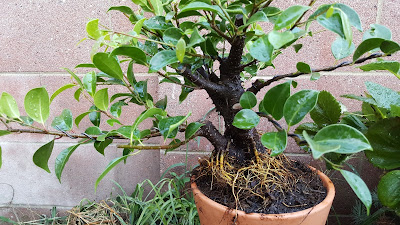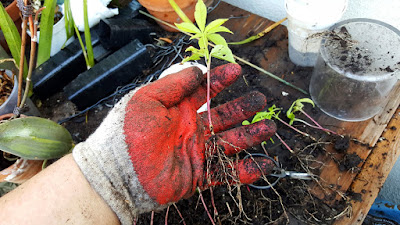I grow my seedling in dirt I get from my local home improvement center. After rooting my cuttings I put them in the same dirt. I use this soil because I know that my plants will grow very well in it. In the bonsai world there is this whole bias against common soil. The worst thing you can put your tree in the mind of bonsai lovers is regular soil.
I remember reading once that a bonsai lover went to an older man's house to buy some bonsai. Apparently the older man had an extensive collection of bonsai. However, the older man was not able to take care of this collection any longer. The trees had fallen into disrepair. Some of the trees had died. The first criticism that the bonsai lover made was that these trees had been potted in regular soil. His thinking was that the soil did damage to the tree. I thought to myself, “that's probably why the trees hung on for as long as they did”.
I will start an experiment. I will grow some seeds in akadama and some in soil. I will also plant some rooted cuttings, and I will use deciduous trees and evergreens. I will also use broad leaved trees and conifers. I will water them and feed them the same amounts.
I do not have anything against baked clays. I use Turface in my soil mixes. Hard baked clays are very porous. They retain a lot of water without making the soil soggy. The clay is hard but can be broken down by roots. Hard clays in my belief are good in bonsai soil mixtures. I do dislike the suggestion that 100 percent akadama is the only soil for bonsai. Heck, if that were true why even plant trees in the ground? The big draw back to Hard baked clays is that they have zero nutrition for the plants. This may not be a big deal as many bonsai trees are on feeding schedules.
"(1.) Do you use akadama? If so, for all your trees? And for trees in all stages of development?
Yes, I use akadama for all my trees. I use less akadama on the tree in training (25% or less). - Boonyarat Manakitivipart (Bonsai Boon)
I try to use Akadama for Japanese maples since I have found nothing better. Unfortunately price and unreliability of supply in the USA means that this is not always possible. I also use recycled Akadama as a partial ingredient in general purpose soils. - Colin Lewis
I haven't used Akadama on my own trees for over 10 years now; there have been occasions a client has insisted on using it for deciduous trees (that can be bare-rooted) but I always refuse to repot a coniferous species into Akadama. Pines and Junipers cannot have a complete soil-change to remove Akadama and repotting is infrequent; it stands to reason that any akadama introduced into the soil of a Pine or Juniper will become very compacted before there is an opportunity to remove it. - Harry Harrington
The answer is simple, because I do not use Akadama. Have tried it and it doesn't do its job here. It doesn't fit the growing conditions around here (Northern Europe), it is expensive, and other high quality soils are available at low costs. Denmark is a country with a proud gardening history and a well developed greenhouse tradition, which has contributed with a lot of research and development bringing forward the best soil mixtures for container growing i.e. So why import a soil when very good and tested soils are at hand? - Morten Albek
No, in Indonesia, we only use volcanic lava soil from Indonesia for all of our Bonsai. for all stages. Excellent and cheap! - Robert Steven"
So, just like everything else in bonsai it really is up to the individual. Where you live, and how you grow bonsai determines what you use for soil.
If you keep reading the article you will see that some people vigorously defend akadama, some people will use it if they can get it or not if it is not available, and some people will claim that akadaa can harm your tree. Experiment coming soon. Cheers.



















































